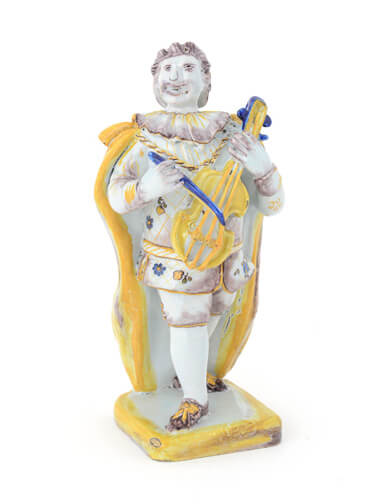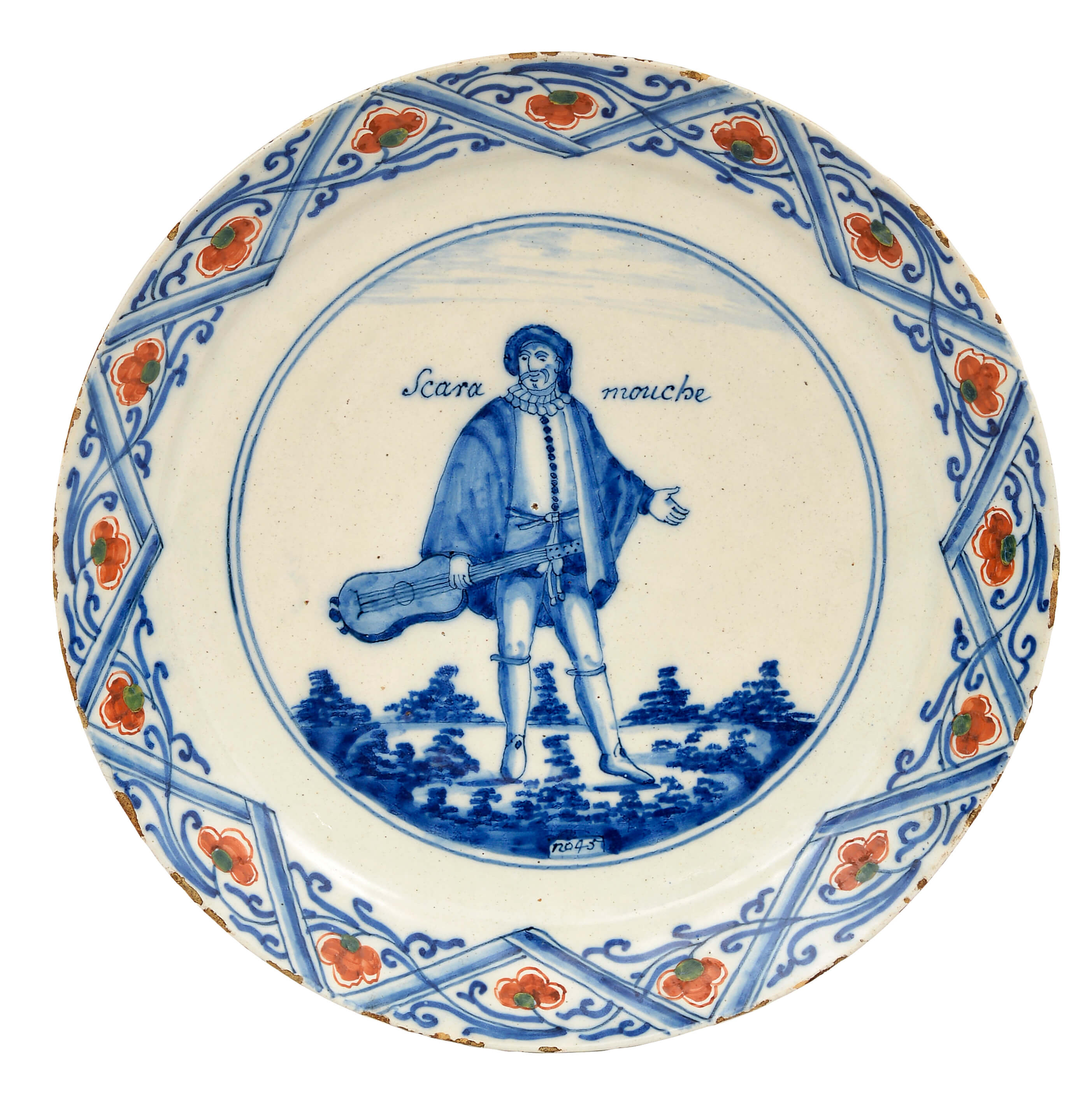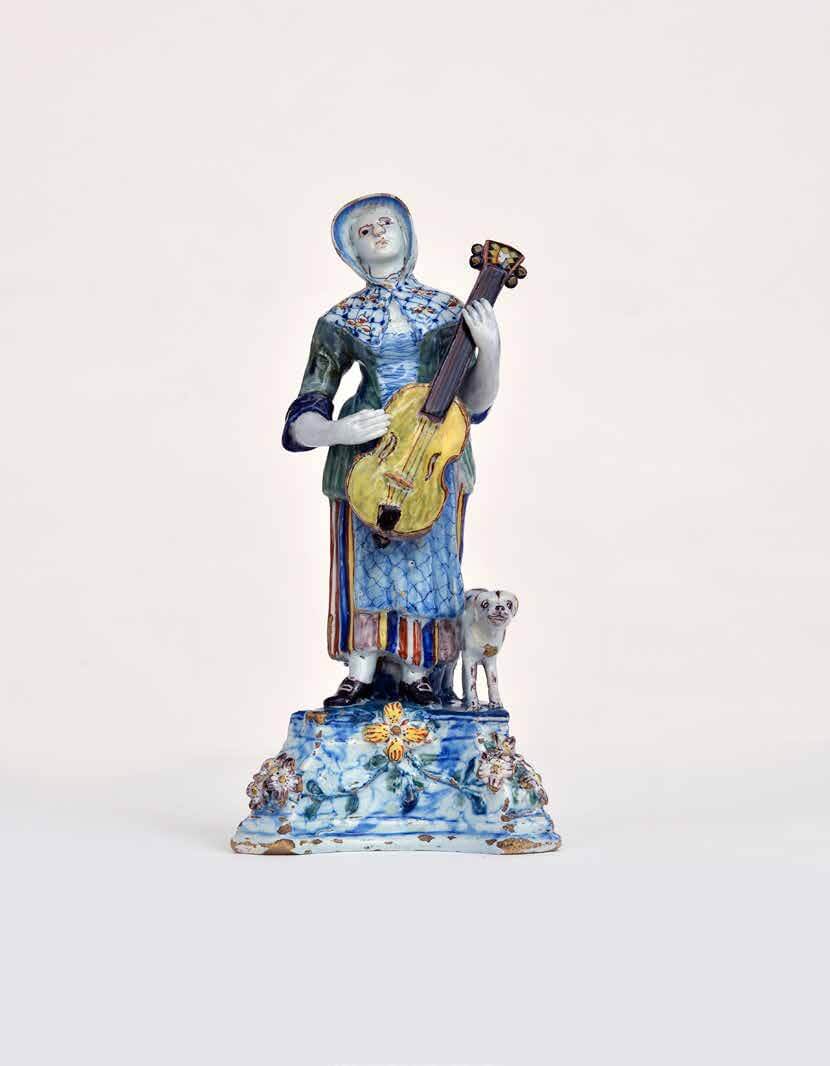
Delft & The Commedia dell’Arte
For centuries the Commedia dell’Arte (Italian Comedy) has been a source of inspiration for painters, printmakers and porcelain manufacturers throughout Europe. This had as result that the subject appeared almost in every medium of the fine and decorative arts.

The Commedia dell’Arte was a form of comedy theater characterised by masked types which began in Italy in the sixteenth century, possibly as a reaction to the political and economics crisis of that century. It was a form of theater in which professional players improvised on a fixed theme. The characters were recognizable by their mask and costume. Besides a jester and a merchant, there was a range of other characters such as the female servant Colombine and the brave Capitano. Since the Italian players travelled through all the regions of Europe, the names of the least known actors occasionally changed from region to region. The troupes had not only a considerable influence on the local theatre traditions, but also on the fine and decorative arts.[1] In response to the rising popularity of the Commedia dell’Arte in Italy, France, Germany and the Netherlands in the first half of the eighteenth century, the potters in the city of Delft decided to produce plates and figures with the imagery of the theatre piece.

Possibly, because of the expressive nature of acting and the plasticity of ceramics as a medium, however, some of the most successful representations of these comic actors have appeared in and on pottery. For example this polychrome plate with the depiction of Scaramouche, one of the standard actors, who was a stock clown character. By his grimaces and affected language he entertained the audience; he could be clever or stupid, just as the actor sees fit to portray him. His role is described as the following: “He was tall and very upright…although he was such a large eater, he was one of the most agile players ever seen…In character, he was extremely suspicious, miserly and hot-tempered. He had a lively imagination but rarely spoke, having great difficulty in expressing in words what he wished to say but, in return, nature had endowed him with a wonderful talent which enabled him to explain by the postures of his body and the grimaces of his face, all that he desired.”[2] The image of Scaramouche on this plate may have been based on a late seventeenth-century engraving of ‘Scaramouche’ by Antoine Trouvain (1656-1708) or on a engraving by Tiberio Fiorilli (1608-1694) used as the frontispiece from Angelo Constantini’s La Vie de Scarmouche of 1695. The similarities of the engraving and the painted scene in the center on the plate are striking: the actor wearing a floppy hat, a ruff around his neck, a mid-length cape, a buttoned doublet and knee breeches, holding a guitar in his hand and gesturing with his other hand. As mentioned earlier, the characters of the Commedia dell’Arte appear not only on plates and other flatware, but also in the shape of figurines. For example, a statuette of Scaramouche is in the collection of the Rijksmuseum, Amsterdam.[3]
Also statuettes of other characters of the Commedia dell’Arte were made in Delft in the eighteenth century, such as this figure of Mezzetin. Mezzetin, like so many of his fellow Italian Comedians, was a servant, a rascal, a gambler and a deceitful trouble-maker, but he was also “a gifted and sensitive musician,” who is occasionally depicted in both prints and ceramic representations playing a guitar, or less frequently a lute.[4] The Delft figure of Mezzetin in our collection is holding a blue bow in his right hand and possibly a yellow viola da gamba in his left. Rare as it is to find an Italian Comedy figure in Dutch Delft, it is extremely unusual to find Mezzetin represented in any form of ceramics with a viola da gamba. Although it was a popular solo instrument, it is most likely that in this instance the figure was a special order for a customer with a particular taste for the music of this resonant stringed instrument.

The Delft potters were not only interested in the musical theme in combination with the Commedia dell’ Arte. Several Delftware pieces are known with the depiction of musical instruments. For example this Delft figural group in our collection, which shows a lady playing a string instrument, with her head tilted back as if to sing, standing beside a small dog. The figure is from a series of four musicians, including a lady lutanist, a male violinist and a male flautist. The string instrument she is holding in her hands is possibly a viola da gamba, but the identity of the instrument is slightly speculative because it is too large to be a violin or viola, too small to be a cello, and not the correct shape to be a guitar or a mandolin. Therefore the remaining possibility is a viola da gamba, which seems to have originated in Spain in the second half of the fifteenth century, but became particularly popular during the Renaissance, remaining popular into the eighteenth century. However, a viola da gamba had generally six or seven strings, rather than the four her, its neck curves forward rather than backward, and the body has c-shaped rather than f-shaped holes. Only the size and shape of the body suggest that it is a viola da gamba with which the Delft sculptor and painter may have taken a little artistic licence.
It is obvious that the potters the city of Delft were, just as so many artists, inspired by the Commedia dell’Arte, but that was not all. As a matter of fact, they were inspired by all kinds of music which appeared on several objects. Theater and music; all the arts came together in Dutch Delftware.
Notes
[1] Van Aken-Fehmers, L.A. Schledorn, T.M. Eliëns, Delfts Aardewerk. Geschiedenis van een nationaal product, Volume II, Zwolle / Den Haag (Gemeentemuseum) 2001, p. 118.
[2] Chilton, M. quotes Angelo Constantini, The Birth, Life and Death of Scaramouche (Paris 1695), Chapter 27 in Harlequin Unmasked, The Commedia dell’Arte and Porcelain Sculpture, Toronto (The George R. Gardiner Museum of Ceramic Art) 2001, p. 92.
[3] Rijksmuseum, Amsterdam, inv.no. BK-16393.
[4] Chilton, M. Harlequin Unmasked, The Commedia dell’Arte and Porcelain Sculpture, Toronto (The George R. Gardiner Museum of Ceramic Art) 2001, pp. 97-100.



